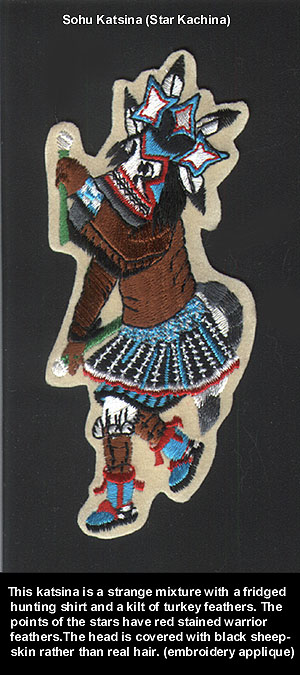The Hopi Star
Kachina
by
Gary A. David
Copyright
© 2004 by Gary A. David
Ascending
at dawn from the subterranean shadows of the kiva, the kachinas stream
into the sunlit plaza of the oldest village in North America. In single file procession
they step as one entity to the steady pulse of a single cottonwood drum. An oblong
loop of spirit dancers soon forms inside the negative space created by clusters
of low, masonry dwellings: a sacred circle within the square, one great kachina
wheel turning in perfect synchronization to the rhythms of the seasons around
the communal heart of Oraibi. Unlike Plains Indians’ sun dance songs which seem
to aggressively pierce the firmament like rays of sunlight, these Hopi songs project
a more moderate and reserved character, due in part to being muffled by the extraordinary
masks, which sometimes even resonate with a soft buzzing. More essentially, however,
this sedentary native group’s attention is primarily focused downward to the earth,
urging the forces of fertility to rise. From daybreak to nightfall with only short
intervals of rest, the singers’ intoned prayers are pressed into the ground by
a series of unremitting dance steps, thereby assisting the tellurian cycle of
horticultural growth in an extremely harsh land. At last the sun slips beyond
the western rim of the horizon and is gone, making its diurnal descent to the
Underworld.
In the simplest sense kachinas
(also spelled katsinam) are intercessory spirits that can take on the form
of any manifold physical object, phenomenon, or creature in the world. Distinct
from the Hopi pantheon, they are not worshipped per se, though certain deities,
such as Masau’u, god of death and the Underworld, can alternately appear as kachinas.
The familiar kachina "dolls" (tihu) are merely representations
of the actual spirit beings, carved for the sake of the children, and in modern
times to sell to tourists.
The most prominent feature of Sohu, or Star Kachina, is the three vertical four-pointed
stars arranged horizontally in a row across the top of his head. These bring to
mind the most important constellation in Hopi cosmology, Orion, in particular
his belt. These stars are interspersed between four vertical eagle feathers. This
kachina has dark straight hair, goggle eyes, and diamond-shaped teeth.
On his right cheek is painted an equilateral cross (star), on his left a crescent
moon. He wears a fringed buckskin shirt and a kilt made of radiating turkey feathers,
both of which are peculiar attire for a kachina. As Barton Wright succinctly
notes, “He does not resemble the usual Hopi Kachina.” The 19th century archaeologist
Jesse Walter Fewkes says that Sohu has stars painted on his forearms and legs.
He holds yucca whips in both hands and a fox skin trails behind him.
The Hopi word sohu (or soohu) simply means “star,” but in
their belief system stars are conceptualized as supernatural entities, with those
of Orion being ceremonially paramount. In the Egyptian Pyramid Texts (some of
the world’s oldest funerary literature) the similar word Sahu refers
to “the star gods in the constellation Orion.”
In addition, we find an important verification for the sky-ground dualism of the
Orion Correlation Theory in both the Egyptian homophone
sahu, which means “property,” and its cognate sah-t, which refers
to “landed property,” “estate,” “site of a temple,” “homestead,” or “environs.”
Because the term sahu simultaneously refers to both stars and ground, this
conceptual mirroring aligns the two realms, i.e., “...on earth as it is in heaven.”
These and other language correlations corroborate if not a Hopi migration from
the Old World, then at least a pre-Columbian contact with Middle Eastern or North
African mariners, perhaps Phoenician or Libyan.
an
excerpt from The Orion Zone: Ancient Star Cities of the American Southwest
Copyright © 2004 by Gary A. David. All rights reserved
Any use of text or photos without the author's prior consent is expressly
forbidden.
Contact: e-mail islandhills@cybertrails.com

